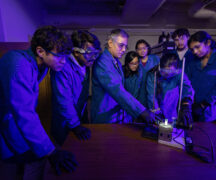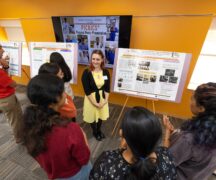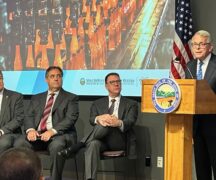From BGSU OFFICE OF MARKETING & COMMUNICATIONS
Bowling Green State University photochemist Dr. Alexis Ostrowski and her lab are venturing into a whole new world of materials with properties as yet unknown, but that offer the promise of beneficial applications in health, industry, agriculture and other fields.
In recognition of the potential of Ostrowski’s work, the National Science Foundation (NSF) has awarded her a CAREER grant of nearly $600,000 to fund her research over the next five years. Ostrowski also recently learned that she has received another $250,000 in funding for a second project looking at using the power of light to transform animal waste into usable fertilizer.
“The Faculty Early Career Development (CAREER) Program is a Foundation-wide activity that offers the National Science Foundation’s most prestigious awards in support of the early career-development activities of those teacher-scholars who most effectively integrate research and education within the context of the mission of their organization,” according to the NSF. “Such activities should build a firm foundation for a lifetime of integrated contributions to research and education.”
“The overall goal of my lab is to make photoresponsive materials,” Ostrowski said. “And those materials have in them metal ions for unique reactivities.”
By mixing metal ions with polymers, or plastics, and exposing the resulting materials to light, Ostrowski aims to open up new avenues of discovery.
“We may be making materials with really interesting properties we don’t even know yet. This is fundamental research,” she said.
“Alexis is a rising star in the field of inorganic photochemistry, applying well-constructed experiments and syntheses to novel materials and photochemical reactivity,” said Dr. Malcolm Forbes, director of the Center for Photochemical Sciences. “She combines her excellent training in mechanistic inorganic photochemistry with creative ideas that push the field of biomaterials to new directions, in particular to make light-responsive polysaccharides and to study light-induced modification of surfaces.”
For the past four years, Ostrowski and her students have been conducting research and gathering preliminary data on which to build the foundation for the current project, “Controlling Mechanical Properties of Materials Using Photoactive Metal Coordination Bonds.”
The papers she and they have published in scholarly journals have drawn the attention of other researchers and led to her also recently being named one of 16 “ Emerging Investigators in Inorganic Photochemistry and Photophysics” by the American Chemical Society.
The CAREER grant will allow her to continue her work and will fund graduate research assistants and undergraduate students in her lab.

Alexis Ostrowski (third from left) with her student lab team (left to right) Sandeep Sahoo, Travis Green, Kalani Edirisinghe, Ankit Dara and Jayan Karunarathna. (BGSU Photo)
As a chemist, Ostrowski said, she sees the world through a different lens than do nonchemists.
“A basic difference between chemists and nonchemists is that we tend to think a lot on the molecular level,” she said. “It all comes back to what are the interactions of the molecules with each other. You want to very selectively control the interactions of those molecules, so you build into the material certain kinds of interactions. And then if we shine light on the material, what does that do? How can we change those interactions to change the mechanical properties of the materials?”
Once the researchers gain an understanding of how to manipulate the variables to achieve the desired mechanical properties, it will be a matter of customizing them for specific uses. They are already finding that some materials work better together than others.
Although some biomaterials can be photoresponsive, she said, adding in the metal ions creates much greater potential for these new interactions and responsiveness to light. She is not working with actual hard metals but with metal salts, or ions, which are positively charged and can bind to different substances and participate in different processes.
Likewise, she said, certain polymers can respond to light, but it’s usually UV light.
“When you add in metal ions, you get a lot more reactivities; you can use more kinds of light and get more varied responses to light. There are more ‘knobs’ you can tune on how the materials can respond to light.”
Unlike traditional materials whose reactions to stress, for example, are known, and for which mechanical engineers can build models to predict how they will respond, these new materials will have completely different properties.
So far, the data show the concept works – there are indeed changes in mechanical properties of the new materials.
“We can use metal ions to make irreversible changes in polymers so we can pattern in stiff and soft areas in the material, which has health applications,” Ostrowski said. “For example, biological tissues in the skin or heart have really different mechanical properties than you can usually make in a lab. They’re called hierarchical materials, with all these layers of complexity. That’s really difficult to mimic with a plastic, so how are you going to do that? You can shine light on a material in certain areas, and make one area softer and one stiffer. We can really easily change and pattern this material with specific ‘stiffnesses.’”
This has implications for tissue engineering. Collaborator Dr. Rhima Coleman and her team at the University of Michigan, who have grown stem cells in these materials, show how those stem cells start to grow differently depending on where they are, in a softer or stiffer environment. Researchers in tissue engineering thus need to grow cells in materials with unique properties, and this is one of the areas Ostrowski’s CAREER grant is supporting.
The other direction relates to another kind of materials that are not biologically related and may be even more challenging. Ostrowski’s research could help develop coatings on things such as cars that would be not only scratch resistant but that could be “healed” by shining a light on them.
This would seem to contradict basic rules about materials and the relationships between molecules, along with our knowledge about rigid, hard substances.
“This is really difficult to do because when you scratch them, you break apart those bonds. How can we accommodate breaking bonds while maintaining rigidity and strength?” Ostrowski asked. The answer may be to soften them selectivity with light, using the light to manipulate interactions between the molecules in the novel materials.
All this sounds very high tech, and it is, but some of the ideas are bio-inspired, Ostrowski said. Her former colleagues at the University of California at Santa Barbara and in other universities are studying the way in which common mussels attach themselves so firmly to piers and rocks. The mussels, it turns out, have substances in their protein structures that bind to iron ions and create a new material with new properties.
Dr. Carl Carrano at San Diego State University read an early paper from Ostrowski’s lab and is applying the idea to see if brown algae or sea kelp naturally bind to iron ions in water using this same polymer.
“There are many examples in nature of interfaces of inorganic metals with organic polymers and proteins,” Ostrowski said, including how teeth and bones can be both strong and elastic due to the interaction of the hard calcium phosphate and the protein polymers surrounding them.
Ostrowski suspects that as the body of knowledge in this area grows, more of these fascinating interactions between metal ions and polymers will come to light.
The second project for which she received funding adds Ostrowski’s expertise in photochemistry to a study by BGSU chemistry faculty member Dr. Bob Midden and his students on how to turn liquid waste from Concentrated Animal Feeding Operations into fertilizers by encapsulating them into a solid form so that they may be safely transported and spread on fields.
“But changing them into solids also changes how the nutrients in them are released,” Ostrowski said. She will experiment with incorporating all-natural plant polymers with photoreactive iron ions into the pellets to see if the release can be controlled through exposure to sunlight.
The five-year, $250,000 grant from the Herman Frasch Foundation for Agricultural Chemistry will help support a graduate student in Ostrowski’s lab and an undergraduate in Midden’s to continue developing the research.
Ostrowski is as proud of her students’ accomplishments as her own.
“She is a dedicated mentor to her students, who have found success on the BGSU campus through the HATCH program, in addition to attractive employment opportunities in the Midwest,” Forbes said. “She is also an outstanding teacher. What I find particularly impressive in Alexis, as a colleague in the chemistry department and the Center for Photochemical Sciences, is her ability to juggle so many responsibilities in research, teaching and service with superior professional competence whilst maintaining a collegial and hospitable demeanor. She is a prime example of the excellent leadership of women in science currently being developed across the United States.”





